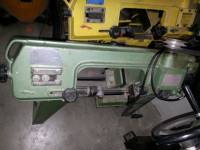Table of Contents
Horizontal Bandsaws
VHS has two horizontal bandsaws that are for cutting metal and plastic stock down to usable lengths for machining on the various machine tools such as the lathe and mills. These are NOT wood bandsaws.
Yellow
This bandsaw has a blade installed that is specifically for cutting larger solid aluminium or plastic stock. Do not use this bandsaw for ferrous metals (e.g. steels) nor small (~1/4“ [6mm] or less) stock!
| Status | Operational as of 2013-11-20 |
|---|---|
| Training | Mandatory |
| Hackable | NO |
| Usage Restrictions | Members Only |
| Owner | Richard Sim |
| If it Breaks | Unplug machine, put a “broken” sign on machine, contact Richard. |
| Loan Status | Semi-Permanent |
| Arrival Date | November 2012 |
| Location | Workshop |
| Champion | See Compendium of Champions |
Green
This bandsaw has a blade installed that is specifically for cutting smaller stock of non-ferrous metals (e.g. aluminium), ferrous metals (e.g. steels), and plastic stock. Due to the smaller tooth pitch on the blade it is suitable for cutting smaller stock than the other bandsaw. If you are cutting aluminium or plastic stock that is suitable for the other bandsaw, please use it instead as those materials will tend to gum up/damage this bandsaws blade (and it's approximately 4x the price!).
| Status | Operational as of 2013 |
|---|---|
| Training | Mandatory |
| Hackable | NO |
| Usage Restrictions | Members Only |
| Owner | VHS |
| If it Breaks | Unplug machine, put a “broken” sign on machine, contact Richard. |
| Loan Status | Semi-Permanent |
| Arrival Date | November 2013 |
| Location | Workshop |
| Champion | See Compendium of Champions |
Replacement Blades
Both bandsaws use 64 1/2” x 1/2“ blades. 14 TPI bi-metal for the yellow bandsaw, and 18-24 TPI either bi-metal or regular for the Green.
Safety
Required:
- Safety Glasses
- An experienced bandsaw operator (training is required! They're simple machines but very easily misused, abused, and broken. Training is very quick; don't think you can skip it.)
Optional (but recommended):
- Hearing Protection
- Dust protection
Prohibited:
- Gloves (NEVER use gloves near rotating machinery!)
- Loose clothing
- Loose hair
Tutorial
- Select the correct bandsaw for your material and its size. If the material/size is appropriate for the Yellow bandsaw, it should always be the one chosen. Only use the Green bandsaw if the Yellow bandsaw is inappropriate - it has a much (~4x) more expensive blade installed that can be gummed up/damaged by the materials/sizes that are better suited to the Yellow bandsaw. As a general rule there should be no less than 3 teeth of the blade in contact with the material at any time (too many is an issue also, as the teeth will fill with material before they can be cleared, generating excessive heat, softening the teeth and welding the material to the blade).
- Drag the bandsaw out (don't try to tilt it up to get it to roll on its wheels, it's VERY dangerous and hard. They seriously slide much better than they roll).
- Clear the area of any obstructions.
- Lift up the blade (it'll stay open).
- Open the vice with the handle at the end of the bandsaw.
- Slide the material into place in the vice, ensuring there is enough material still in the vice to be well secured.
- Tighten the vice with the handle at the end of the bandsaw.
- Have appropriate coolant/lubricant on hand for the material being cut.
- Place something below the material that will be cut off to catch it - it will likely be VERY HOT and sharp. Do not try to catch it (as you are NOT to wear gloves when using automated machinery). Do not let it drop onto the ground as it will make a loud sound that will startle people (dangerous if they're doing something with tools/machinery) and potentially damage the floor.
- Ensure the power switch is OFF.
- Plug in the bandsaw.
- Stand clear of the blade and turn the power switch ON.
- Gently lower the blade onto the material and let it cut through its own weight/power.
- Apply coolant/lubricant to the cut generously throughout the cutting process.
- Do not apply any pressure to the blade to try to make it cut faster - you will break the blade!!! It will cut at the appropriate speed. If you want to apply pressure to the cut, please use a hand hacksaw and have fun applying as much pressure as you like while you cut it by hand instead.
- Once the material has been cut, the bandsaw will turn itself off automatically. There is no need to 'catch' the bandsaw nor try to turn it off at the right moment.
- Unplug the bandsaw and gently wrap the power cord around it to keep it neat and off the floor.
- Slide back into its storage location.
- Clean up any coolant/lubricant and swarf (chips) from the material that is on the floor.
Maintenance Log
| Note | Date | Who |
|---|---|---|
| Wiki entry created | Nov 20, 2013 | Thomas L. |
| Wiki entry updated | Oct 17, 2015 | Richard S. |


